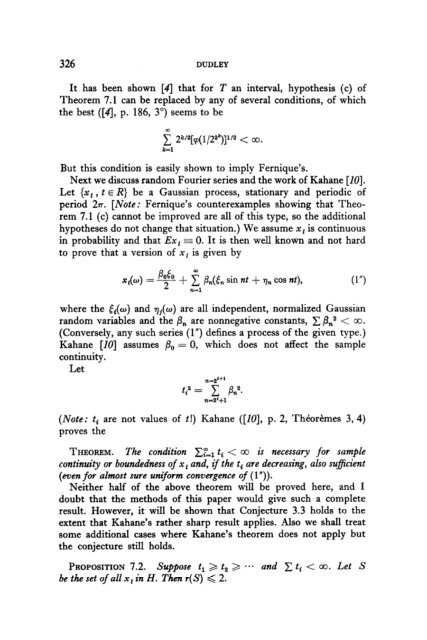On the Characters and the Plancherel Formula of Nilpotent Groups ...
On the Characters and the Plancherel Formula of Nilpotent Groups ...
On the Characters and the Plancherel Formula of Nilpotent Groups ...
Create successful ePaper yourself
Turn your PDF publications into a flip-book with our unique Google optimized e-Paper software.
326 DUDLEY<br />
It has been shown [A that for T an interval, hypo<strong>the</strong>sis (c) <strong>of</strong><br />
Theorem 7.1 can be replaced by any <strong>of</strong> several conditions, <strong>of</strong> which<br />
<strong>the</strong> best ([4J p. 186, 3”) seems to be<br />
f 2k’2[,(1/29’/” < co.<br />
k=l<br />
But this condition is easily shown to imply Fernique’s.<br />
Next we discuss r<strong>and</strong>om Fourier series <strong>and</strong> <strong>the</strong> work <strong>of</strong> Kahane [IO].<br />
Let {xt , t E R) be a Gaussian process, stationary <strong>and</strong> periodic <strong>of</strong><br />
period 27r. [Note: Fernique’s counterexamples showing that Theo-<br />
rem 7.1 (c) cannot be improved are all <strong>of</strong> this type, so <strong>the</strong> additional<br />
hypo<strong>the</strong>ses do not change that situation.) We assume xt is continuous<br />
in probability <strong>and</strong> that Ex, z 0. It is <strong>the</strong>n well known <strong>and</strong> not hard<br />
to prove that a version <strong>of</strong> xt is given by<br />
q(u) = 9 + f f3,(& sin nt + 7n cos nt),<br />
n-1<br />
(1”)<br />
where <strong>the</strong> &(o) <strong>and</strong> Q( w ) are all independent, normalized Gaussian<br />
r<strong>and</strong>om variables <strong>and</strong> <strong>the</strong> /3, are nonnegative constants, C &a < 00.<br />
(Conversely, any such series (1”) defines a process <strong>of</strong> <strong>the</strong> given type.)<br />
Kahane [JO] assumes /3,, = 0, which does not affect <strong>the</strong> sample<br />
continuity.<br />
Let<br />
11.+,‘+1<br />
ti2 = c &2.<br />
s--e'+1<br />
(Note: ti are not values <strong>of</strong> t!) Kahane ([IO], p. 2, Theoremes 3, 4)<br />
proves <strong>the</strong><br />
THEOREM. The condition C& t, < co is necessary for sample<br />
continuity or boundedness <strong>of</strong> xt <strong>and</strong>, if <strong>the</strong> ta are decreasing, also s@icient<br />
(even for almost sure uniform convergence <strong>of</strong> ( 1”)).<br />
Nei<strong>the</strong>r half <strong>of</strong> <strong>the</strong> above <strong>the</strong>orem will be proved here, <strong>and</strong> I<br />
doubt that <strong>the</strong> methods <strong>of</strong> this paper would give such a complete<br />
result. However, it will be shown that Conjecture 3.3 holds to <strong>the</strong><br />
extent that Kahane’s ra<strong>the</strong>r sharp result applies. Also we shall treat<br />
some additional cases where Kahane’s <strong>the</strong>orem does not apply but<br />
<strong>the</strong> conjecture still holds.<br />
PROPOSITION 7.2. Suppose t, > t, 2 - -- <strong>and</strong> C t, < 00. Let S<br />
be <strong>the</strong> set <strong>of</strong> all xI in H. Then r(S) < 2.

















